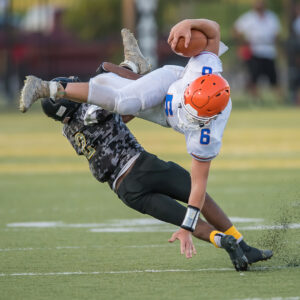Injury Prevention for Football Players

Football is more than just a high-contact sport; it’s a high-intensity game played with great bursts of speed, sharp turns, sudden jumps, and quick landings—putting football players at greater risk of injuries. While some injuries are unavoidable, many noncontact injuries can be prevented with proper training and conditioning.
Orlin & Cohen’s Dr. Christopher Wild, a certified sports physical therapist, reviews football training tips and dynamic stretching exercises you can incorporate into your training and practice routine—during the season and after—to reduce your risk of common football injuries.
Develop raw strength and power
There’s no denying it. Football players who are bigger and stronger than their opponents are more likely to perform better on the field.
Training to lift as much as possible can go a long way, but when designing a well-rounded weight training program for football players, programs should focus on developing both strength and power. While many may use the terms interchangeably, there is a difference.
- Strength refers to how much weight an individual can move. Strength training sets typically include eight to 10 repetitions, where reps are executed at the heaviest weight possible.
- Power refers to how fast an individual can move a certain amount of weight. Power training sets include three to five repetitions, where reps are completed as quickly as possible.
Squatting, deadlifting, and chest and shoulder pressing are important weight training exercises for football players. Complete reps with an emphasis on weight and speed for a training regimen that better prepares you for gameplay dynamics.
Plyometrics
Plyometric exercises also develop power. When completing plyometrics, football players train to move their body weight as quickly—and explosively—as possible.
The most popular plyometric exercises for football players include the broad jump, vertical/box jump, skater jump, and plyometric pushups. Exercises like these help players develop and improve their body control, which translates into improved performance on the field.
Dynamic stretching
We’ve all heard that we should stretch before we exercise. While this is partially true, most people don’t understand that there are two different types of stretching—static and dynamic—and depending on what you’re doing, each has distinct benefits.
- Static stretching improves flexibility and range of motion. During a static stretch, you take a muscle to its end range and hold it there for a set amount of time.
- Dynamic stretching improves speed, agility and acceleration. During a dynamic stretch, you take your muscles through a full range of motion repeatedly during the stretch—taking a muscle to its end range, returning to neutral, and repeating.
While static stretching is important, football players—like most athletes—benefit from dynamic stretching routines since these stretches closely resemble gameplay movements. Here are some dynamic stretching exercises frequently used by Orlin & Cohen’s sports medicine specialists:
- Walking knee hugs: While walking, raise and pull one knee to your chest—alternate knees with each step.
- Walking leg kicks: Walking with outstretched arms, kick one leg in front of you—alternate legs with each step.
- Walking heel pull: Grab your foot behind your back and pull it towards your butt—alternate legs with each step.
- Walking sidesteps: Facing sideways, take a large step laterally and sit into the lead leg, stretching the trailing leg’s groin muscle.
- Lunge with twist: Step forward and drop your back knee to the ground, twist over the front leg. Alternate legs on the next step forward and twist in the opposite direction.
Football players can perform this dynamic stretching routine on the football field and complete a different stretch every 15 to 30 yards.
Core strengthening
When it comes to training the core, there are three main areas to condition: the pelvis, the abdomen, and the rib cage. Working together, your core muscles provide stability during different movements by either transmitting or absorbing forces. We’ll explain:
- Force transmission happens during self-initiated movements, like running, jumping, and throwing. With these actions, the core is responsible for transmitting forces outward and stabilizing muscles as extremities push outward.
- Force absorption happens during movements where the core absorbs the force from an external load. With these actions, the core stabilizes and gives you the support to absorb forces without losing your center of gravity—critical for catching a pass or taking a hit without giving up the ball.
While there are many different ways to condition and build strength in your core, the sports medicine experts at Orlin & Cohen suggest the following exercises to football players looking to train their core for both force transmission and absorption.
To get started, you’ll need an oversized medicine ball and a solid, sturdy wall—like a brick wall.
- Chest pass: Establish an athletic position facing the wall. Hold the medicine ball at your chest and pass it into the brick wall. Be ready to receive the ball without getting knocked out of position.
- Scoop pass: In an athletic position with your hips perpendicular to the wall, bring the medicine ball to the hip furthest from the wall, twist and drive your rear hip through to toss your ball and face the wall—ready to receive the ball back. Reverse on the opposite side.
- Overhead slam: Holding the medicine ball in both hands, bring it overhead, and slam it down into the ground as hard as you can.
Football injury treatment
While some football injuries are unavoidable, many can be minimized or prevented altogether with a comprehensive exercise program.
If you’re experiencing pain while training or playing, listen to your body. Instead of working through injuries, seek medical care. Treating an injury right away can help you recover faster and prevent more serious injuries.
As part of our commitment to young athletes, Orlin & Cohen offers sports medicine programs designed exclusively for high school and collegiate students, including a Walk-in Sunday Sports Medicine Clinic and Recovery & Injury Screening Services.
Our premier team of fellowship-trained sports medicine specialists have the expertise and experience to help you feel better and get back in the game, faster. Orlin & Cohen’s network of offices is open seven days a week: Request an appointment.



